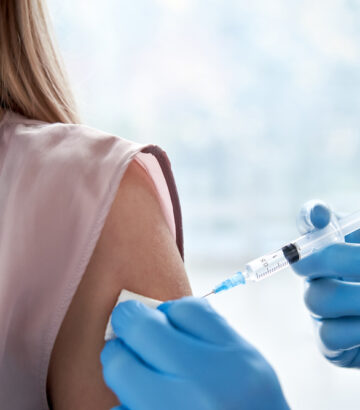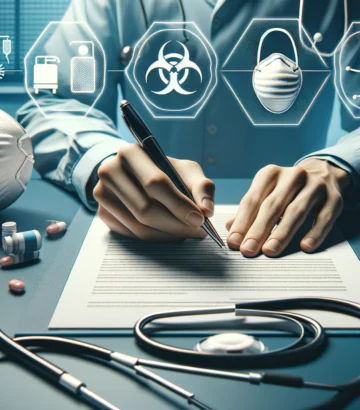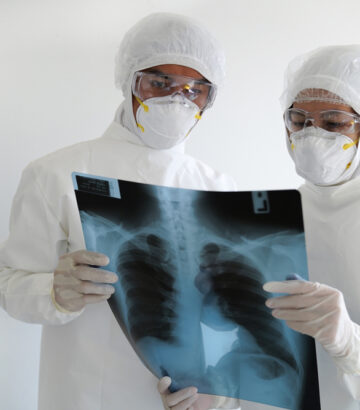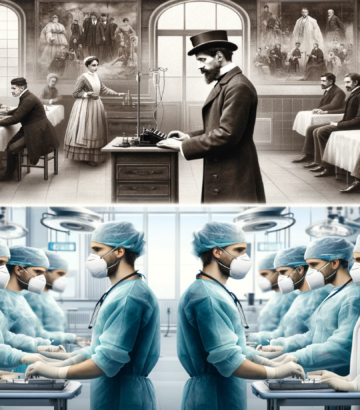Open Letter to Medical Associations
Reprinted with permission
Authors: Dr. Golda Schlaff, Dr. Spela Salamon, Ph.D, Dr. Sandra Deuretzbacher, Dr. Ingrid Fuchs, Univ.-Prof. Dr. Mariann Pavone-Gyöngyösi, Dr. Wolfgang Hagen, Univ.-Prof. Priv.-Doz. Dr. Kathryn Hoffmann, MPH, Dr. Martin Komenda-Lett, Dr. Oliver Lammel, Priv.-Doz. Dr. Stefan Pfaffenberger, Dr. Christian Tögl, Dr. Verena Tögl, Priv.-Doz. Dr. Arschang Valipour, Dr. Muhammad Yacob, Prim. Univ.-Prof. Dr. Udo Zifko
1. Informing and Educating the general population
As healthcare professionals, we must always act to the best of our knowledge and beliefs. We provide information about the benefits, risks and side effects of medications and medical interventions. We also point out the possible long-term consequences of everyday behaviors such as smoking, alcohol consumption, sunburns, eating habits, and infectious diseases.
The majority of the population cannot and does not want to imagine that a simple viral infection can lead to serious, long-term health issues. However, we know that this is not rare; human papilloma virus (HPV) and Epstein-Barr Virus (EBV) may cause cancer (cervix, pharynx, lymphoma, etc.) years later. An untreated HIV infection manifests as AIDS only after several years. This also applies to bacteria: Borrelia and Treponema pallidum can lead to severe neurological diseases months to years later. Once pathogens spread systemically, the site of the primary infection no longer determines the course of the disease.
It is common practice in science to use currently available research data to make predictions for the future. The scientific community has been conducting intensive research in the area of COVID-19 and its sequelae for over 3 years. We have extensive preclinical, clinical, and postmortem data from around the world. Once you are aware of these data, the handling of the pandemic and the management of this health crisis are absolutely appalling. We CANNOT take responsibility for the continuous, unmitigated spread of a vascular-damaging, neurotropic virus, such as SARS-CoV-2, where prior infections fail to provide long-term protection against future infections! Due to infections and reinfections, people are losing their healthy life years, and the excess mortality rate is persistently too high. In Europe alone, 36 million people have become chronically ill owing to SARS-CoV-2 infections. COVID-19 is not just a runny nose or common cold. It is a systemic, primarily vascular disease that spreads mainly through the respiratory route via aerosols.
The continued, uncontrolled spread of the virus not only poses immediate and long-term health risks, but also creates an environment in which the virus evolves and develops capabilities for immune escape, as well as drug and vaccine resistance.
2. Regular, mandatory training for doctors and interdisciplinary exchange
Based on experience, it can be said that the majority of physicians lack knowledge of the current scientific data. Many doctors likely obtain their information about COVID-19 primarily from mass media, rather than from serious medical journals and peer-reviewed scientific studies. This must urgently change! Physicians need to be better trained to provide their patients with reliable and accurate information. Continued interdisciplinary education on COVID-19 should be made mandatory. A deeper understanding and knowledge of the following topics are essential:
- Transmission routes and survival of SARS-CoV-2 (aerosols!)
- Knowledge of infection-prevention and air quality control methods
- Correlation between disease risk and severity and infectious dose (viral load)
- Use of anti-viral medications
- SARS-CoV-2 infection has systemic effects:
- It causes endothelial damage to our vessels and the formation of microclots (common target organs: heart, lungs, brain, kidneys, intestines, toes etc.) (1-16)
- It behaves neurotropically, leading to neurological disorders such as headaches, hearing loss, loss of smell, neuropathic pain, fatigue, cognitive impairment, neurodegeneration and dementia-like symptoms (17-31)
- It can lead to changes in the immune system, such as immune dysfunction with increased susceptibility to infections, or act as a trigger for autoimmune processes (type I diabetes, neuropathies, vasculitis, rheumatic diseases, GBS). (32-41)
- Long COVID, Post-COVID, PASC, ME/CFS: definitions, symptoms, theories of development (persistent viral reservoirs found throughout all organ-systems for months after infection; activation of dormant viruses), diagnosis, and therapy (42-48)
- Cumulative risks and long-term consequences of reinfections: risks for thrombosis, myocardial infarction, pulmonary embolism, stroke, neurodegenerative diseases, autoimmune diseases, immunodeficiency, etc., increase with each additional infection. (49-54)
- Known risks in children, pregnant women, athletes, healthcare workers, healthy adults, and people with pre-existing health conditions (55-80).
3. Use of preventive measures and exemplary behavior in everyday clinical practice
Since the removal of mandatory protective measures in the medical field, all patients, including highly vulnerable individuals, are being exposed to the risks of a SARS-CoV-2 infection in primary care settings as well as in hospitals. Many people have no way to reliably protect themselves in healthcare settings and are thus forced to contract COVID-19.
Policymakers have declared the pandemic over and equated SARS-CoV-2 with a rhinovirus. However, COVID-19 is neither over nor a harmless infection without consequences. Medical professionals must take an exemplary role and act to protect all people, and NOT continue to submit to the pressures of society, media, and politics. Simple, yet very effective infection prevention measures include the following:
- Use of CO2-monitors indoors
- Good ventilation by means of built in ventilation systems or open windows
- Air purification with HEPA filters (in winter or where ventilation is limited)
- Testing and isolation in case of symptoms or contact with COVID-19 patients
- Registry of COVID-19 cases; Insight into vigilance system (e.g., wastewater data, hospitalizations, deaths)
- FFP2/N95 respirator masks or better
- Reserve blocked time slots on defined days for vulnerable individuals
- Establish a voluntary list of physicians, who adhere to preventive measures
We ask the Medical Associations to advocate for the development of long-term strategies to manage this health crisis. We ask that you reinvigorate the idea of prevention! It is also critical to increase collaboration within the medical community and to facilitate the sharing of knowledge and data related to COVID-19 and its sequelae. Now is the time to demonstrate leadership, unity, and an unwavering commitment to the well-being of the general population. By applying a comprehensive, strategic, and sustained approach, we can effectively control the transmission and impact of SARS-CoV-2 through simple means. We are confident that you will show dedication to our profession and promote the highest
standards of patient safety and care. We hope to hear from you soon, and look forward to working with you.
References
- Damage to endothelial barriers and their contribution to long-term COVID. Wu X, et al. s.l. : Angiogenesis, 2023.
- Long-term cardiovascular outcomes of COVID-19. Xie Y, et al. s.l. : Nat Med, 2022.
- Long-term cardiovascular outcomes in COVID-19 survivors among non-vaccinated population: A retrospective cohort study from the TriNetX US collaborative networks. Wang W, et al. s.l. : EClinicalMedicine, 2022.
- One-Year Adverse Outcomes Among US Adults With Post-COVID-19 Condition vs Those Without COVID-19 in a Large Commercial Insurance Database. DeVries A, et al. s.l. : JAMA Health Forum, 2023.
- Association of COVID-19 with short- and long-term risk of cardiovascular disease and mortality: a prospective cohort in UK Biobank. Wan EYF, et al. s.l. : Cardiovascular Research, 2022.
- Intestinal Damage, Inflammation and Microbiota Alteration during COVID-19 Infection (Review). Saviano A, et al. s.l. : Biomedicines, 2023.
- Damage to endothelial barriers and its contribution to long COVID (Review). Wu X, et al. s.l. : Angiogenesis, 2022.
- Persistent SARS-CoV-2 infection in patients seemingly recovered from COVID-19. Bussani R, et al. s.l. : J Pathol, 2023.
- Outcomes of Cardiovascular Magnetic Resonance Imaging in Patients Recently Recovered From Coronavirus Disease 2019 (COVID-19). Puntmann VO, et al. s.l. : JAMA Cardiol, 2020.
- COVID-19 and cutaneous manifestations: A review of the published literature (Review). Martora F, et al. s.l. : Journal of Cosmetic Dermatology, 2022.
- Livedo reticularis as a presenting sign of severe acute respiratory syndrome coronavirus 2 infection. Khalil S, et al. s.l. : American Academy of Dermatology Association, 2020.
- Cerebral small vessel disease pathology in COVID-19 patients: A systemaic review. Owens CD, et al. s.l. : Ageing Research Reviews, 2023.
- Vascular Dysfunctions Contribute to the Long-term Cognitive Deficits Following COVID-19. Shabani Z, et al. s.l. : preprints.org (preprint), 2023.
- Long-term cardiac pathology in individuals with mild initial COVID-19 illness. Puntmann VO, et al. s.l. : Nature Medicine, 2022.
- Coronary microvascular health in symptomatic patients with prior COVID-19 infection: an updated analysis. Ahmad AI, et al. s.l. : European Heart Journal Cardiovascular Imaging, 2023.
- Long COVID and the cardiovascular system—elucidating causes and cellular mechanisms in order to develop targeted diagnostic and therapeutic strategies: a joint Scientific Statement of the ESC Working Groups on Cellular Biology of the Heart and Myocardial . Gyöngyösi M, et al. s.l. : Cardiovasc Res, 2023.
- Neuroinflammation After COVID-19 with Persistent Depressive and Cognitive Symptoms. Braga J, et al. 2023, JAMA Psychiatry.
- Cerebral blood flow in patients recovered from mild COVID-19. Sen S, et al. s.l. : J Neuroimaging, 2023.
- Brain hypoxia, neurocognitive impairment, and quality of life in people post-COVID-19. Adingupu DD, et al. s.l. : Journal of Neurology, 2023.
- SARS-CoV-2 Infects the Brain Choroid Plexus and Disrupts the Blood-CSF Barrier in Human Brain Organoids. Pellegrini L, et al. s.l. : Cell Stem Cell., 2020.
- Long-term neurologic outcomes of COVID-19. Xu E, et al. s.l. : Nat Med, 2022.
- The functional and structural changes in the hippocampus of COVID-19 patients. Nouraeinejad A, et al. s.l. : Acta Neurol Belg, 2023.
- Severe Neuro-COVID is associated with peripheral immune signatures, autoimmunity and neurodegeneration: a prospective cross-sectional study. Etter MM, et al. s.l. : Nat Commun, 2022.
- SARS-CoV-2 infection and persistence in the human body and brain at autopsy. Stein SR, et al. s.l. : Nature, 2022.
- Cortical Grey matter volume depletion links to neurological sequelae in post COVID-19 “long haulers”. Rothstein TL, et al. s.l. : BMC Neurol, 2023.
- SARS-CoV-2 is associated with changes in brain structure in UK Biobank. Douaud G, et al. s.l. : Nature, 2022.
- The cerebral network of COVID-19-related encephalopathy: a longitudinal voxel-based 18F-FDG-PET study. Kas A, et al. s.l. : Eur J Nucl Med Mol Imaging, 2021.
- One year on: an updated systematic review of SARS-CoV-2, COVID-19 and audio-vestibular symptoms. Almufarrij I, et al. s.l. : Int J Audiol, 2021.
- Alzheimer’s-like signaling in brains of COVID-19 patients. Reiken S, et al. s.l. : Alzheimers Dement., 2022.
- Risk factors and abnormal cerebrospinal fluid associate with cognitive symptoms after mild COVID-19. Apple AC, et al. s.l. : Ann Clin Transl Neurol., 2022.
- Vagus nerve inflammation contributes to dysautonomia in COVID-19. Woo MS., et al. s.l. : medRxiv (preprint), 2023.
- Immune mechanisms underlying COVID-19 pathology and post-acute sequelae of SARS-CoV-2 infection (PASC) (Review). Mohandas S, et al. s.l. : Elife, 2023.
- New Onset of Autoimmune Diseases Following COVID-19 Diagnosis (REVIEW). Gracia-Ramos AE, et al. s.l. : Cells., 2021.
- Immune-mediated neurological syndromes in SARS-CoV-2-infected patients. Guilmot A, et al. s.l. : J Neurol, 2021.
- Impaired function and delayed regeneration of dendritic cells in COVID-19. Winheim E, et al. s.l. : PLoS Pathog, 2021.
- Risk of autoimmune diseases in patients with COVID-19: A retrospective cohort study. Chang R, et al. s.l. : EClinicalMedicine, 2023.
- Association of COVID-19 Vaccination With Risk for Incident Diabetes After COVID-19 Infection. Kwan AC, et al. s.l. : JAMA Netw Open, 2023.
- Risk for newly diagnosed diabetes after COVID-19: a systematic review and meta-analysis. Zhang T, et al. s.l. : BMC Med, 2022.
- Immunological dysfunction persists for 8 months following initial mild-to-moderate SARS-CoV-2 infection. Phetsouphanh C, et al. s.l. : Nat Immunol, 2022.
- Distinguishing features of Long COVID identified through immune profiling. Klein J, et al. s.l. : medRxiv (preprint), 2022.
- High risk of autoimmune diseases after COVID-19. Sharma C, et al. s.l. : Nature Reviews Rheumatology, 2023.
- Biomarkers in long COVID-19: A systematic review. Lai YJ, et al. s.l. : Front Med (Lausanne), 2023.
- Postacute COVID-19 is Characterized by Gut Viral Antigen Persistence in Inflammatory Bowel Diseases. Zollner A, et al. s.l. : Gastroenterology, 2022.
- Gastrointestinal manifestations of long COVID: A systematic review and meta-analysis. Choudhury A, et al. s.l. : Therap Adv Gastroenterol., 2022.
- Persistent SARS-CoV-2 Infection, EBV, HHV-6 and Other Factors May Contribute to Inflammation and Autoimmunity in Long COVID (Review). Vojdani A, et al. s.l. : Viruses, 2023.
- Long COVID: major findings, mechanisms and recommendations (Review). Davis HE, et al. s.l. : Nat Rev Microbiol, 2023.
- Characterizing long COVID in an international cohort: 7 months of symptoms and their impact. Davis HE, et al. s.l. : EClinicalMedicine, 2021.
- Long COVID: pathophysiological factors and abnormalities of coagulation. Turner S, et al. s.l. : Trends in Endocrinology and Metabolism, 2023.
- COVID-19 as a risk factor for long-term mortality in patients managed by the emergency medical system: A prospective, multicenter, ambulance-based cohort study. Martin-Conty JL, et al. s.l. : Front Public Health, 2023.
- High prevalence of persistent symptoms and reduced health-related quality of life 6 months after COVID-19. Ahmad I, et al. s.l. : Front Public Health, 2023.
- Analysis of well-annotated next-generation sequencing data reveals increasing cases of SARS-CoV-2 reinfection with Omicron. Burkholz S, et al. s.l. : Commun Biol, 2023.
- Risks of deep vein thrombosis, pulmonary embolism, and bleeding after covid-19: nationwide self-controlled cases series and matched cohort study. Katsoularis I, et al. s.l. : BMJ, 2022.
- Acute and postacute sequelae associated with SARS-CoV-2 reinfection. Bowe B, et al. s.l. : Nat Med, 2022.
- Incident autoimmune diseases in association with a SARS-CoV-2 infection: A matched cohort study (preprint). Tesch F, et al. s.l. : medRxiv, 2023.
- Ocular manifestations of COVID-19 in pediatric patients (Review). Ichhpujani P, et al. s.l. : Ther Adv Ophthalmol., 2023.
- Long-COVID in children and adolescents: a systematic review and meta-analyses. Lopez-Leon S, et al. s.l. : Sci Rep, 2022.
- SARS-CoV-2 variant-related abnormalities detected by prenatal MRI: a prospective case-control study. Kienast P, et al. s.l. : Lancet Reg Health Eur, 2023.
- Aerobic capacity of professional soccer players before and after COVID-19 infection. Parpa K, et al. s.l. : Sci Rep., 2022.
- Pulmonary Dysfunction after Pediatric COVID-19. Heiss R, et al. s.l. : Radiology, 2022.
- Evidence for Biological Age Acceleration and Telomere Shortening in COVID-19 Survivors. Mongelli A, et al. s.l. : Int J Mol Sci, 2021.
- Mid- and Long-Term Atrio-Ventricular Functional Changes in Children after Recovery from COVID-19. Sabatino J, et al. s.l. : J Clin Med, 2022.
- Maternal SARS-CoV-2, Placental Changes and Brain Injury in 2 Neonates . Benny M, et al.
2023 : Pediatrics. - Long-Term Effect of COVID-19 on Lung Imaging and Function, Cardiorespiratory Symptoms, Fatigue, Exercise Capacity, and Functional Capacity in Children and Adolescents: A Systematic Review and Meta-Analysis. Campos C, et al. s.l. : Healthcare, 2022.
- Cerebrovascular Complications of COVID-19 Disease in Children: A Single-Center Case Series. Spanelova K, et al. s.l. : Pediatric Neurology, 2022.
- Left ventricular longitudinal strain alterations in asymptomatic or mildly symptomatic paediatric patients with SARS-CoV-2 infection. Sirico D, et al. s.l. : European Heart Journal – Cardiovascular Imaging, 2022.
- COVID-19 Associated Vasculitis Confirmed by the Tissues RT-PCR: A Case Series Report. Belozerov KE, et al. s.l. : Biomedicines, 2023.
- Cardiac screening prior to return to play after SARS-CoV-2 infection: focus on the child and adolescent athlete: A Clinical Consensus Statement of the Task Force for Childhood Health of the European Association of Preventive Cardiology. D’Ascenzi F, et al. s.l. : European Journal of Preventive Cardiology, 2022.
- COVID-19 and athletes: Endurance sport and activity resilience study—CAESAR study. Sliz D, et al. s.l. : Front Physiol., 2022.
- Vascular alterations among male elite athletes recovering from SARS-CoV-2 infection. Bauer P, et al. s.l. : Scientific Reports, 2022.
- Low Cardiorespiratory Fitness Post-COVID-19: A Narrative Review. Schwendinger F, et al. s.l. : Sports Medicine, 2023.
- Respiratory muscle strength and pulmonary function in unvaccinated athletes before and after COVID-19 infection: A prospective cohort study. Bostanci Ö, et al. s.l. : Respiratory Physiology and Neurobiology, 2023.
- Effects of SARS-CoV-2 on prenatal lung growth assessed by fetal MRI. Stoecklein S, et al. s.l. : Lancet Respir Med., 2022.
- Adverse maternal, fetal, and newborn outcomes among pregnant women with SARS-CoV-2 infection: an individual participant data meta-analysis. Smith ER, et al. s.l. : BMJ Global Health, 2022.
- The effects of preconception and early gestation SARS-CoV-2 infection on pregnancy outcomes and placental pathology. Hernandez PV, et al. s.l. : Annals of Diagnsotic Pathology, 2023.
- The placental pathology in Coronavirus disease 2019 infected mothers and its impact on pregnancy outcome. Joshi B, et al. s.l. : Placenta, 2022.
- SARS CoV-2 detected in neonatal stool remote from maternal COVID-19 during pregnancy. Jin JC, et al. s.l. : Pediatric Research, 2022.
- Viral persistence in children infected with SARS-CoV-2: current evidence and future research strategies. Buonsenso D, et al. s.l. : The Lancet Microbe, 2023.
- Long-term multiple metabolic abnormalities among healthy and high-risk people following nonsevere COVID-19. Washirasaksiri C, et al. s.l. : Nature – Scientific Reports, August 2023.
- Determinants of the onset and prognosis of the post-COVID-19 condition: a 2-year prospective observational cohort study. Mateu L, et al. s.l. : The Lancet, September 2023.
- SARS-CoV-2 reservoir in post-acute sequelae of COVID-19 (PASC). Proal AD, et al. s.l. : Nature Immunology, September 2023.
Press Coverage
https://exxpress.at/offener-brief-15-aerzte-schlagen-wegen-ueberlastung-der-spitaeler-alarm/
https://www.meinbezirk.at/c-gesundheit/aerzte-fordern-corona-schutzmassnahmen_a6257826
https://taz.de/Infektion-mit-Covid-19/!5965594/
More signatures:
https://covidisnotover.info/oeffentlicher-brief-an-aerztekammer
Adapted German Letter to Dental Associations in Germany
Sehr geehrte Damen und Herren,
Das World Health Network setzt sich angesichts der COVID-19-Pandemie für den Schutz der Gesundheit und die Minimierung der Schäden für den Einzelnen und die Gesellschaft ein. Wir engagieren uns für die Beendigung der Pandemie und die Förderung einer gesünderen, widerstandsfähigeren Welt.
Es ist uns ein Anliegen, mit diesem Brief an die oberste ärztliche berufliche Priorität zu erinnern: Der Schutz der Gesundheit der Patienten und Patientinnen.
Die Zahnmedizin spielt hier eine besondere Rolle. Patientinnen und Patienten ist es nicht möglich, sich während einer Zahnbehandlung effektiv vor Infektion zu schützen, während Selbstschutz bei einer nicht-zahnärztlichen Behandlung mithilfe einer Maske durchaus möglich ist. Den zahnärztlichen Praxen fällt daher eine außergewöhnliche Verantwortung beim Infektionsschutz zu. Mit diesem Schreiben möchten wir der Zahnärztekammer Informationen über die möglichen Maßnahmen an die Hand geben.
Doch zuvor ein paar Fakten zu Covid:
- Die Inzidenz, die das RKI veröffentlicht, hat keine valide Datenbasis, da es keine stringente Teststrategie mehr gibt. Es ist anzunehmen, dass die 7-Tage-Inzidenz der SentiSurv der Universität Mainz in Höhe von 1.267 pro 100.000 Personen (Dashboard SentiSurv RLP (unimedizin-mainz.de), Stand 11.10.2023) auf ganz Deutschland übertragbar ist.
- Die Anzahl der öffentlichen Covid-Todesfälle in Deutschland betrug in den letzten 12 Monaten 22.152; im Vergleich dazu starben im selben Zeitraum 1.096 Personen an Influenza (2023-38.pdf (rki.de)).
- Das Risiko für Post-Covid-19 beträgt laut WHO 10 – 20 % (https://www.who.int/news-room/questions-and-answers/item/coronavirus-disease-(covid-19)-post-covid-19-condition.). Andere Experten gehen von 6 % aus. (RKI – Coronavirus SARS-CoV-2 – Long COVID (Stand: 22.8.2023).
Wenn man die Inzidenz 1.267 der SentiSurv als Basis nimmt und von 6 % ausgeht, bedeutet das, dass in Deutschland täglich über 9.000 Menschen durch eine Covid-Infektion chronisch erkranken.
Fazit: Covid ist weiterhin eine Krankheit mit tiefgreifenden gesellschaftlichen Auswirkungen.
Nachfolgend finden Sie eine nach Zustimmung der Autorinnen und Autoren minimal angepasste Version des offenen Briefes von 15 prominenten Ärztinnen und Ärzten aus Österreich an die dortige Ärztekammer.
1. Aufklärung der Allgemeinbevölkerung
Als Beschäftigte im Gesundheitswesen handeln wir immer nach bestem Wissen und Gewissen. Wir klären auf über Nutzen, Risiken und Nebenwirkungen von Medikamenten und medizinischen Eingriffen. Wir weisen auch auf mögliche Langzeitfolgen von Alltagsverhalten hin, wie z.B. beim Rauchen, Alkohol, Sonnenbrand, Essgewohnheiten, Infektionskrankheiten usw.
Der Großteil der Bevölkerung kann und will sich nicht vorstellen, dass eine einfache virale Infektion längerfristig zu schwerwiegenden Problemen führen kann. Wir wissen aber, dass das gar nicht so selten ist: Humane Papillomaviren (HPV) und Epstein-Barr-Viren (EBV) können Jahre später zu Krebs (Zervix, Pharynx, Lymphome uvm.) führen. Eine unbehandelte HIV-Erkrankung wird erst nach mehreren Jahren als AIDS auffällig. Und bei Bakterien ist es nicht anders: Borrelien und Treponema pallidum können Monate bis Jahre später zu schweren neurologischen Erkrankungen führen. Wenn sich Krankheitserreger systemisch ausbreiten, hat der „Ort“ der Primärinfektion nichts mehr mit dem Krankheitsverlauf zu tun.
So wie es in der Wissenschaft üblich ist, ist es unsere Aufgabe, die uns zur Verfügung stehenden Forschungsdaten zu nutzen, um realistische Prognosen für die Zukunft zu erstellen. Seit über drei Jahren wird intensiv im Bereich COVID-19 und Folgeschäden geforscht. Wir haben zahlreiche präklinische, klinische und post-mortem Daten aus der ganzen Welt. Wenn man sich diese Daten ansieht, ist der Umgang mit der Pandemie und das Management dieser Gesundheitskrise absolut erschreckend. Wir können eine ständige, unmitigierte Durchseuchung der Bevölkerung mit einem Gefäß-schädigenden, neurotropen Virus wie SARS-CoV-2, bei dem eine frühere Infektion nicht längerfristig vor einer weiteren Infektion schützt, nicht verantworten! Durch Infektionen und Reinfektionen sehen wir bereits jetzt, dass den Menschen gesunde Lebensjahre verloren gehen, die Übersterblichkeit anhaltend zu hoch ist, und alleine in Europa 36 Millionen Menschen als Folge einer SARS-CoV-2 Infektion chronisch krank geworden sind. COVID-19 ist kein Schnupfen. Es ist kein grippaler Infekt. Es ist eine systemische, Gefäß-schädigende Erkrankung, die sich lediglich über den respiratorischen Weg, über Aerosole, ausbreitet.
Die fortgesetzte, unkontrollierte Ausbreitung des Virus birgt nicht nur unmittelbare und längerfristige Gesundheitsrisiken, sondern schafft auch ein Umfeld, in dem das Virus evolviert und Fähigkeiten zur Immunabwehr und Medikamentenresistenz entwickelt.
2. Regelmäßige, verpflichtende Fortbildungen und interdisziplinärer Austausch
Empirisch hat es sich leider gezeigt, dass die Mehrheit der Ärzteschaft nicht auf dem aktuellen Stand der Wissenschaft ist und ihr Wissen über COVID-19 und den längerfristigen Folgen primär aus den allgemeinen Medien, statt aus seriösen medizinischen Fachjournalen und wissenschaftlichen Studien bezieht. Das muss sich dringend ändern! Ärzte und Ärztinnen gehören besser geschult – damit sie ihre Patienten und Patientinnen besser aufklären können.
Laufende, interdisziplinäre Fort- und Weiterbildungen zum Thema COVID-19 sollten verpflichtend sein. Tieferes Wissen zu den folgenden Themen zu besitzen wäre essenziell:
- Übertragungswege und Überlebensdauer von SARS-CoV-2 (Aerosole!)
- Maßnahmen zur Infektionsprävention und Aufklärung über Lufthygiene
- Zusammenhang zwischen Krankheitsverlauf und Infektionsdosis
- Einsatz von Virustatika
- SARS-CoV-2 wirkt systemisch:
- Es führt zu Endothelschäden an unseren Gefäßen und zu Mikrothromben (häufige Zielorgane: Herz, Lunge, Gehirn, Nieren, Darm, Zehen, Haut, usw.) (1-16)
- Es verhält sich neurotrop und führt zu neurologischen Störungen wie Kopfschmerzen, Hörverlust, Geruchsverlust, neuropathischen Schmerzen, Erschöpfung, kognitiven Einschränkungen, neurodegenerativen und demenzartigen Symptomen (17-31)
- Es kann zu Veränderungen im Immunsystem führen, wie Immundysfunktionen mit erhöhter Infektanfälligkeit oder auch als Trigger für Autoimmunprozesse wirken (Diabetes Typ I, Neuropathien, Vaskulitis, Rheumatische Erkrankungen, GBS) (32-41)
- Long-Covid, Post-Covid, PASC, ME/CFS: Definitionen, Symptome, Theorien zur Entstehung (Virale Persistenz in verschiedenen Organsystemen; Reaktivierung schlummernder Viren), Diagnose, und Therapie (42-48)
- Kumulative Risiken und Langzeitfolgen bei Reinfektionen: Risiken für Thrombose, Herzinfarkt, Lungenembolie, Schlaganfall, neurodegenerative Erkrankungen, Autoimmunerkrankungen, Immunschwäche usw. steigen mit jeder zusätzlichen Infektion. (49-54)
- Risiken bei Kindern, Schwangeren, Sporttreibenden, vorerkrankten und gesunden Erwachsenen, inklusive Gesundheitspersonal (55-80)
3. Einsatz von präventiven Maßnahmen und vorbildhaftes Verhalten im klinischen Alltag
Seit dem Wegfall der offiziellen Schutzmaßnahmen im medizinischen Bereich werden Patienten und Patientinnen, inklusive vulnerable Personen, sowohl im niedergelassenen Bereich als auch in Krankenhäusern dem Risiko einer Infektion mit SARS-CoV-2 ungehindert ausgesetzt. Viele Menschen haben keine Möglichkeit, sich verlässlich zu schützen, und werden, im Rahmen des Gesundheitswesens, zu einer möglicherweise folgenschweren COVID-19 Infektion gezwungen.
Die Politik hat die Pandemie für beendet erklärt und SARS-CoV-2 mit einem Rhinovirus gleichgesetzt. Die WHO als zuständige Organisation hat die Pandemie allerdings nicht für beendet erklärt, sondern nur die “emergency phase” (“… This does not mean the pandemic itself is over, but the global emergency it has caused is, for now.”) (81). COVID-19 ist also weder vorbei, noch ist es eine harmlose Infektion ohne Folgen. Die Ärzteschaft muss eine vorbildhafte Funktion einnehmen und Maßnahmen zum Schutz aller Menschen setzen und sich nicht weiter dem gesellschaftlichen, medialen und politischen Druck beugen.
Einfache, jedoch sehr wirksame Maßnahmen zur Infektionsprävention wären:
- Einsatz von CO2-Messgeräten in Innenräumen
- Gute Ventilation mittels Lüftungsanlagen bzw. offene Fenster
- Luftreinigung mit HEPA-Filtern (im Winter oder wo Ventilation nur eingeschränkt möglich ist)
- Testungen und Isolation bei Symptomen, Testung bei Kontakt mit COVID-19 Erkrankten
- COVID-19 als meldepflichtige Erkrankung beibehalten und Einsicht ins Vigilanz-System ermöglichen (z.B. Abwasserdaten, Hospitalisierungen, Todesfälle)
- FFP2 Masken
- Geblockte Zeitfenster an definierten Tagen für vulnerable Personen reservieren
- Freiwillige Ärzteliste, wo präventive Maßnahmen eingehalten werden, erstellen
Wir bitten die Zahnärztekammern, sich für die Entwicklung von langfristigen Strategien zum Management dieser Gesundheitskrise einzusetzen. Wir bitten Sie, den Präventionsgedanken wieder zu stärken!
Entscheidend ist auch, die Zusammenarbeit innerhalb der medizinischen Gemeinschaft zu intensivieren und den Austausch von Wissen und Daten in Zusammenhang mit COVID-19 und deren Folgeschäden zu erleichtern. Jetzt ist die Zeit, in der wir Führungsstärke, Einheit und eine unerschütterliche Verpflichtung zum Wohle der Allgemeinbevölkerung zeigen müssen. Durch die Anwendung eines umfassenden, strategischen und nachhaltigen Ansatzes können wir mit einfachen Mitteln die Übertragung und Auswirkung von SARS-CoV-2 wirksam eindämmen.
Wir sind zuversichtlich, dass Sie sich mit Hingabe für Patientinnen und Patienten einsetzen und höchste Standards in der Patientenversorgung fördern werden. Wir hoffen auf eine baldige Rückmeldung.











